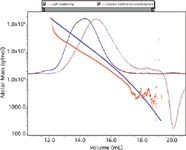Polycarbonate-Urethane Molar Mass Distributions
Analysis of polycarbonate urethanes (PCUs) are a class of biocompatible polyurethanes that show great promise for use in orthopedic implants, such as artificial hips.
Analysis of polycarbonate urethanes (PCUs) are a class of biocompatible polyurethanes that show great promise for use in orthopedic implants, such as artificial hips.
Traditional implant wear surfaces made from ultrahigh molecular weight polyethylene (UHMWPE) generate wear debris that induce osteolysis, causing the implant to loosen and ultimately require surgical replacement. PCU has been found to have lower friction properties than UHMWPE and has a modulus of elasticity similar to cartilage, resulting in PCU having superior wear behavior compared to UHMWPE (1). The molar mass distribution of PCU is of critical importance for its performance in medical device applications.
The molar mass distribution of a PCU resin was characterized using size exclusion chromatography (SEC) in N,N-dimethylacetamide (DMAc) containing 0.1-M lithium bromide. The SEC separation employed a pair of Tosoh Bioscience TSK-Gel Alpha-M columns, followed by Wyatt miniDAWN TREOS and Optilab rEX detectors connected in series. The molar mass distributions of PCU samples were measured using SEC-MALS, and also using conventional column calibration with a series of narrow polystyrene standards.

Figure 1: Comparison of polycarbonate-urethane absolute molar mass measured using SEC-MALS, versus apparent molar mass relative to polystyrene standards. The 90° light scattering (solid line) and refractive index (dashed line) chromatograms are overlaid.
The PCU molar mass calculated using MALS is plotted versus retention volume in Figure 1. The column calibration plot using polystyrene standards is shown in Figure 1 for comparison. The differential molar mass distribution plots from light scattering and column calibration are compared in Figure 2. The molar mass was greatly overestimated using column calibration with polystyrene standards, due to the significant difference in the size in solution of a polystyrene molecule compared to a PCU molecule of the same molar mass. The Mw value of the PCU resin as measured by column calibration was 134,600 g/mol, compared to the actual value of 60,800 g/mol measured by SEC-MALS.

Figure 2: Comparison of the differential molar mass distribution plots obtained for a polycarbonate-urethane resin using SEC-MALS versus column calibration with polystyrene standards.
References
(1) R.W. Treharne and A.H. Greene, "The Case for the Use of Polycarbonate-Urethane in Orthopedic Implants," Med-Tech Precision (2008).
This note graciously submitted by Jason Todd, Polymer SolutionsIncorporated, Blacksburg, VA.

Wyatt Technology Corporation
6300 Hollister Avenue, Santa Barbara, CA 93117
tel. (805) 681-9009, fax (805) 681-0123
Website: www.wyatt.com

SEC-MALS of Antibody Therapeutics—A Robust Method for In-Depth Sample Characterization
June 1st 2022Monoclonal antibodies (mAbs) are effective therapeutics for cancers, auto-immune diseases, viral infections, and other diseases. Recent developments in antibody therapeutics aim to add more specific binding regions (bi- and multi-specificity) to increase their effectiveness and/or to downsize the molecule to the specific binding regions (for example, scFv or Fab fragment) to achieve better penetration of the tissue. As the molecule gets more complex, the possible high and low molecular weight (H/LMW) impurities become more complex, too. In order to accurately analyze the various species, more advanced detection than ultraviolet (UV) is required to characterize a mAb sample.















